Prunus emarginata
Prunus emarginata, the bitter cherry[2] or Oregon cherry, is a species of Prunus native to western North America, from British Columbia south to Baja California, and east as far as western Wyoming and New Mexico.[3][4] It is often found in recently disturbed areas or open woods on nutrient-rich soil.[5][6][7]
| Prunus emarginata | |
|---|---|
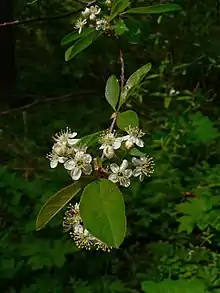 | |
| Prunus emarginata leaves and flowers | |
| Scientific classification | |
| Kingdom: | Plantae |
| Clade: | Tracheophytes |
| Clade: | Angiosperms |
| Clade: | Eudicots |
| Clade: | Rosids |
| Order: | Rosales |
| Family: | Rosaceae |
| Genus: | Prunus |
| Subgenus: | Prunus subg. Cerasus |
| Species: | P. emarginata |
| Binomial name | |
| Prunus emarginata | |
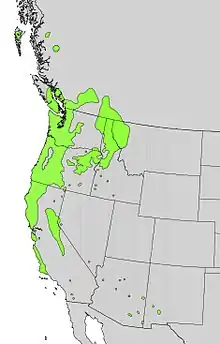 | |
| Natural range | |
| Synonyms[1] | |
| |
Description
Prunus emarginata is a deciduous shrub or small tree growing to 1–15 metres (3+1⁄2–49 feet) tall with a slender oval trunk with smooth gray to reddish-brown bark with horizontal lenticels. As a tree west of the Cascade Crest the species commonly reaches 80 to a maximum of over 100 feet tall. The leaves are 2–8 centimetres (3⁄4–3+1⁄8 inches) long, thin, egg-shaped, and yellowish-green with unevenly sized teeth on either side. The flowers are small, 10–15 millimetres (3⁄8–5⁄8 in) diameter, with five white petals and numerous hairlike stamens; they are almond-scented, and produced in clusters in spring, and are pollinated by insects. The fruit is a juicy red or purple cherry 7–14 mm (1⁄4–1⁄2 in) diameter, which, as the plant's English name suggests, are bitter. As well as reproducing by seed, it also sends out underground stems which then sprout above the surface to create a thicket.[6][7][8]
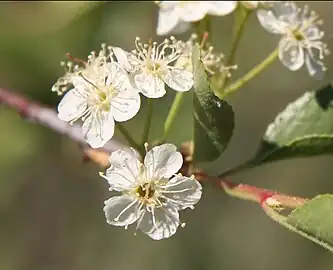 Flowers
Flowers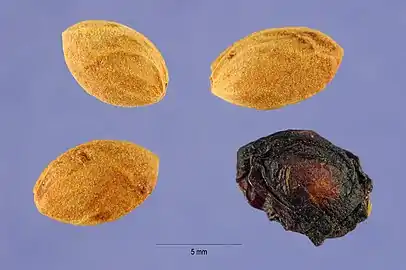 Pits
Pits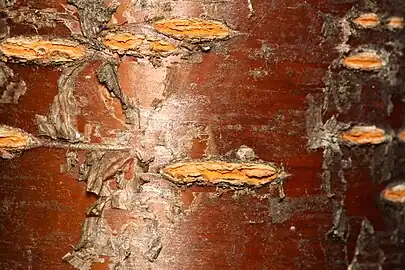 Bark
Bark
There are two varieties:[6][2]
- Prunus emarginata var. emarginata. Usually shrubby; young shoots and leaves hairless or only thinly hairy. Most of the species' range.
- Prunus emarginata var. mollis (Dougl.) Brew. A larger tree; young shoots and leaves downy. Reddish-brown bark with light horizontal bands resembling water birch.[9] Oregon north to British Columbia, mainly coastal.
Similar species
Prunus pensylvanica, the pin cherry, is closely related.[9]
Ecology
Mammals, deer and livestock forage on the leaves.[10] The cherries are eaten by some birds (especially cedar waxwing),[11] who in turn distribute the seeds.[9] The seeds have hard shells which can preserve them for decades before being released by fire.[9]
The tree is a larval host to the blinded sphinx, elegant sphinx, Lorquin's admiral, pale tiger swallowtail, small-eyed sphinx, spring azure, twin-spotted sphinx, and western tiger swallowtail.[12]
Cultivation
It has hybridized with the introduced European Prunus avium in the Puget Sound area; the hybrid has been named Prunus × pugetensis. It is intermediate between the parent species, but is nearly sterile, producing almost no cherries.[13]
Uses
The extremely bitter cherries are inedible to humans.[11] Native Americans used the bark in basket making.[9]
Medicinal
Native tribes, most notably Kwakwaka'wakw, used parts of the plant for medicinal purposes, such as poultices and bark infusions.[14] The isoflavone prunetin was isolated for the first time by Finnemore in 1910 from the bark of P. emarginata.[15]
References
- The Plant List, Prunus emarginata (Douglas ex Hook.) Walp.
- USDA, NRCS (n.d.). "Prunus emarginata". The PLANTS Database (plants.usda.gov). Greensboro, North Carolina: National Plant Data Team. Retrieved 14 October 2015.
- Biota of North America Program 2014 county distribution map
- SEINet, Southwestern Biodiversity, Arizona chapter photos, description, distribution map
- "Prunus emarginata". Germplasm Resources Information Network. Agricultural Research Service, United States Department of Agriculture. Retrieved 26 December 2017.
- Plants of British Columbia: Prunus emarginata
- Jepson Flora: Prunus emarginata
- Flora of North America, Prunus emarginata (Douglas) Eaton, Man. Bot. ed. 7. 463. 1836. Bitter cherry
- Arno, Stephen F.; Hammerly, Ramona P. (2020) [1977]. Northwest Trees: Identifying & Understanding the Region's Native Trees (field guide ed.). Seattle: Mountaineers Books. pp. 242–245. ISBN 978-1-68051-329-5. OCLC 1141235469.
- Little, Elbert L. (1994) [1980]. The Audubon Society Field Guide to North American Trees: Western Region (Chanticleer Press ed.). Knopf. p. 467. ISBN 0394507614.
- Peattie, Donald Culross (1953). A Natural History of Western Trees. New York: Bonanza Books. p. 538.
- The Xerces Society (2016), Gardening for Butterflies: How You Can Attract and Protect Beautiful, Beneficial Insects, Timber Press.
- Jacobson, A. L. & Zika, P. F. (2007). A new hybrid cherry, Prunus × pugetensis (P. avium × emarginata, Rosaceae), from the Pacific Northwest. Madroño 54: 74–85. Abstract
- Casebeer, M. (2004). Discover California Shrubs. Sonora, California: Hooker Press. ISBN 0-9665463-1-8
- Isoflavones. III. The structure of prunetin and a new synthesis of genistein. R. L. Shriner, C. J. Hull, J. Org. Chem., 1945, 10 (4), pp 288–291
